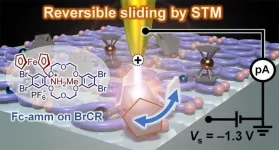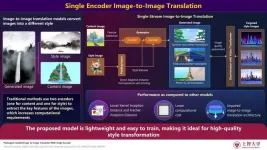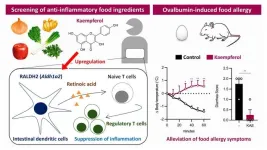(Press-News.org) Craniopharyngioma (CP) is a rare brain tumor that develops in the regions close to the hypothalamus and pituitary gland. The CP tumors lead to complications like defective vision, neuronal defects, diabetes, and developmental problems. There are two primary subtypes of CPs: adamantinomatous craniopharyngioma (ACP) and papillary craniopharyngioma (PCP). These two subtypes are distinguished by their distinct genetic profiles. ACP is typically characterized by mutations in the CTNNB1 gene, while PCP is primarily associated with BRAF gene mutations.
The primary course of action for treating CP is surgical intervention. However, the tumor's invasive nature and its location near critical structures present a significant challenge in terms of surgical intervention. As the tumor progresses, it infiltrates the surrounding tissue, resulting in significant neurological impairments. Therefore, surgery alone is insufficient to address the complex challenges posed by CPs. It is essential to have a comprehensive understanding of the tumor's biological characteristics and molecular progression in order to ensure successful tumor extraction while preserving surrounding healthy tissue.
Against this backdrop, Professor Tomoaki Tanaka collaborated with Professor Yoshinori Higuchi and Dr. Takashi Kono from the Graduate School of Medicine at Chiba University in Japan to conduct a study to elucidate the underlying biological processes involved in this tumor. The study was made available online on September 30, 2024, and was published in Volume 27 Issue 11 of the journal iScience on November 15, 2024.
To this end, they utilized single-cell RNA sequencing, a technique that reveals differences in gene expression across individual cells, and analyzed 10 cases of CPs.
In an interview, Prof. Tanaka, the senior author of the study, explained the motivation behind it. He said, “Despite being histologically benign, these tumors can significantly impact critical brain structures." "Our goal was to develop more targeted and less invasive therapeutic approaches that could significantly improve patient outcomes and quality of life.”
The single-cell analysis revealed a diverse range of cell types within the tumor microenvironment (TME), including tumor cells, immune cells, and fibroblasts, with varying proportions across cases. The tumor cells were classified into two main subtypes: Type 1, which is predominant in ACP, and Type 2, which is dominant in PCP. The single-cell gene expression data from the ACP and PCP subtypes was clustered to reveal distinct cell types within the tumors. The study identified cell types linked to the development of epithelial cells and the immune response in both ACP and PCP tumors. However, the cell types involved in tumor calcification were particularly prevalent in ACP, while the cell cycle-associated genes were predominant in the PCP type.
Further, the research team observed a notable diversity in macrophage types between the two tumor types. The pro-inflammatory M1 macrophages and inflammation-related markers were found to be higher in ACP, while the anti-inflammatory M2 macrophages were higher in PCP. Accordingly, a higher ratio of M1 and M2 macrophages was correlated with the occurrence of diabetes and pituitary insufficiency.
Additionally, the study identified a prominent cell-cell interaction between cell surface proteins CD44-secreted phosphoprotein 1 (SPP1). This SPP1–CD44 signal from classical M2 inhibited the sustained proliferation of T cells.
This study presents a comprehensive map of cell types within CP tumors and reports a significant relationship between immune cells and clinical symptoms.
Prof. Tanaka highlighted the clinical implications of their findings, stating, “These findings open up the possibility of personalized treatment approaches for patients with CP based on their specific tumor subtype and immune cell composition. Understanding these differences will also assist clinicians in predicting which patients are at higher risk for complications like diabetes insipidus.”
Going ahead, these findings can enable the creation of new targeted therapies that precisely influence the tumor microenvironment and immune cell interactions, ultimately leading to more effective treatments with reduced adverse effects.
About Professor Tomoaki Tanaka
Professor Tomoaki Tanaka is Professor at the Department of Molecular Diagnosis, at Chiba University, Japan. Prof. Tanaka received his Doctor of Medicine degree in 1999 from the Faculty of Medicine Graduate School Doctoral Program at Chiba University. In 2009, he joined as Assistant Prof. at the Graduate School of Medicine, Chiba University. He has 24 years of experience and expertise in metabolism, endocrinology, and tumor biology, with over 220 publications. In recognition of his research contributions, Prof. Tanaka received the Research Encouragement Award from The Endocrine Society of Japan in 2009 and the Chiba Medical Association Award in 2011.
END
Every cell has a story: Tumor and immune cell interactions within craniopharyngiomas
Scientists analyzed individual cells isolated from two craniopharyngioma subtypes to identify the specific cell types, their features, and their crosstalk
2024-12-16
ELSE PRESS RELEASES FROM THIS DATE:
Single-stream image-to-image translation (SSIT): a more efficient approach to image translation
2024-12-16
Among the many artificial intelligence and machine learning models available today for image translation, image-to-image translation models using Generative Adversarial Networks (GANs) can change the style of images. These models work by using two input images: a content image, which is altered to match the style of a reference image. These models are used for tasks like transforming images into different artistic styles, simulating weather changes, improving satellite video resolution, and helping autonomous vehicles recognize different lighting conditions, like day and night.
Now, researchers ...
Flavonoid powerhouse: kaempferol's role in taming allergic responses
2024-12-16
Allergic diseases such as asthma, atopic dermatitis, and food allergies have been increasing in frequency over the last few years. Food allergies in particular affect millions of people worldwide—this includes allergies to foods such as milk, peanuts, eggs and shellfish. They are typically caused by the immune system being hypersensitive to harmless substances in foods and the environment. Flavonoids are chemicals present in various fruits and vegetables that are known to have anti-allergic effects and show promise as natural allergic treatments.
To better understand how these allergies can be treated, let’s look at an interesting anti-allergic mechanism in our cells. ...
It’s worth mixing it up: what combination of policies will lead to a clean energy future?
2024-12-16
How can we ensure that as many households as possible adopt not only solar panels, but also their own battery to store solar energy, a heat pump, and an electric car? Researchers at the Universities of Basel and Geneva have looked into just this question.
Climate protection and the energy revolution must continue to make progress, and private households could make a significant contribution to this goal if they would use environmentally friendly technologies such as solar panels, electric vehicles, and heat pumps. Dr. Mart van der Kam and Professor Ulf Hahnel at the University of Basel, Switzerland, conducted research into the political measures that would be necessary to fully realize ...
Human civilization at a critical junction between authoritarian collapse and superabundance
2024-12-16
A new scientific study published in the journal Foresight concludes that human civilisation is on the brink of the next ‘giant leap’ in evolution. However, progress could be thwarted by centralised far-right political projects such as the incoming Donald Trump administration.
"Industrial civilisation is facing 'inevitable' decline as it is replaced by what could turn out to be a far more advanced ‘postmaterialist’ civilisation based on distributed superabundant clean energy. The main challenge is that industrial civilisation is facing such rapid decline that this could derail the emergence of a ...
Targeting a brain enzyme to curb obesity
2024-12-16
Endocannabinoids in the brain play a key role in food intake and energy use. Modulating the action of these molecules could help fight obesity, say researchers at Université de Montréal’s affiliated hospital research centre (CRCHUM).
For years, Université de Montréal medical professor Stephanie Fulton and her team have been unravelling the mechanisms in the human nervous system that control people’s need to eat and to engage in physical activity, and how their metabolism affects their mood.
Their latest ...
Does the exoplanet Trappist-1 b have an atmosphere after all?
2024-12-16
Trappist-1 b is one of seven rocky planets orbiting the star Trappist-1, located 40 light-years away. The planetary system is unique because it allows astronomers to study seven Earth-like planets from relatively close range, with three of them in the so-called habitable zone. This is the area in a planetary system where a planet could have liquid water on the surface. To date, ten research programmes have targeted this system with the James Webb Space Telescope (JWST) for 290 hours.
The current study, in which researchers from the Max Planck Institute for Astronomy (MPIA) ...
Unlocking the journey of gold through magmatic fluids
2024-12-16
When one tectonic plate sinks beneath another, it generates magmas rich in volatiles such as water, sulphur and chlorine. As these magmas ascend, they release magmatic fluids, in which sulphur and chlorine bind to metals such as gold and copper, and transport these metals towards the surface of the Earth. As the extreme conditions relevant to natural magmas are very difficult to reproduce in the laboratory, the precise role of the different forms of sulphur in metal transport remains highly debated. However, an innovative approach ...
The light of the planet TRAPPIST-1 b measured in two color reveals new insights on the planet’s nature
2024-12-16
New TRAPPIST-1 observations with JWST underscore the complexities of confirming a planet's atmosphere using only broadband thermal emission data. This insight takes on added significance with the newly approved "Rocky Worlds" observation program by Space Telescope Science Institute (STScI) which plans to apply this very method to study numerous rocky exoplanets orbiting cool stars.
The James Webb Space Telescope (JWST) is revolutionizing the study of exoplanets (planets orbiting stars other than the Sun), notably by enabling detailed spectroscopic studies of small rocky planets, but only if ...
Palliative care may improve quality of life for stroke survivors and their family members
2024-12-16
Statement Highlights:
About 800,000 people experience a stroke each year in the U.S., and due to recent advances in acute treatment, more people survive. Many stroke survivors experience long-term physical, mental and emotional health challenges.
Palliative care is both a specialty and an approach to care that focuses on helping stroke survivors and their caregivers cope with these challenges by offering symptom management and improving communication about goals of care and quality of life.
For a variety of reasons, palliative care is often underused, especially among Black, Hispanic and Asian patients.
A new scientific statement from the American Heart Association outlining palliative ...
Children’s Hospital of Philadelphia researchers reveal important themes to improve interactions between police and Black autistic youth
2024-12-16
Philadelphia, December 16, 2024 – Law enforcement provides critical community services, yet Black autistic youth often face elevated risk of negative outcomes during police interactions. In an effort to learn more about these encounters within the autistic community, researchers at the Center for Autism Research at Children’s Hospital of Philadelphia (CHOP) conducted a study to examine perceptions and concerns of Black caregivers of Black autistic children regarding police interactions. The findings, published online today by the journal Autism, revealed important changes that could be made to improve the quality of interactions between police and Black autistic youth.
Autistic ...
LAST 30 PRESS RELEASES:
Groundbreaking mapping: how many ghost particles all the Milky Way’s stars send towards Earth
JBNU researchers propose hierarchical porous copper nanosheet-based triboelectric nanogenerators
A high-protein diet can defeat cholera infection
A more accurate way of calculating the value of a healthy year of life
What causes some people’s gut microbes to produce high alcohol levels?
Global study reveals widespread burning of plastic for heating and cooking
MIT study shows pills that communicate from the stomach could improve medication adherence
Searching for the centromere: diversity in pathways key for cell division
Behind nature’s blueprints
Researchers search for why some people’s gut microbes produce high alcohol levels
Researchers find promising new way to boost the immune response to cancer
Coffee as a staining agent substitute in electron microscopy
Revealing the diversity of olfactory receptors in hagfish and its implications for early vertebrate evolution
Development of an ultrasonic sensor capable of cuffless, non-invasive blood pressure measurement
Longer treatment with medications for opioid use disorder is associated with greater probability of survival
Strategy over morality can help conservation campaigns reduce ivory demand, research shows
Rising temperatures reshape microbial carbon cycling during animal carcass decomposition in water
Achieving ultra-low-power explosive jumps via locust bio-hybrid muscle actuators
Plant-derived phenolic acids revive the power of tetracycline against drug-resistant bacteria
Cooperation: A costly affair in bacterial social behaviour?
Viruses in wastewater: Silent drivers of pollution removal and antibiotic resistance
Sub-iethal water disinfection may accelerate the spread of antibiotic resistance
Three in four new Australian moms struggle with body image
Post-stroke injection protects the brain in preclinical study
Cardiovascular risk score predicts multiple eye diseases
Health: estimated one in ten British adults used or interested in GLP-1 medications for weight loss
Exercise to treat depression yields similar results to therapy
Whooping cough vaccination for pregnant women strengthens babies’ immune system
Dramatic decline in new cases of orphanhood in Uganda driven by HIV treatment and prevention programs
Stopping weight loss drugs linked to weight regain and reversal of heart health markers
[Press-News.org] Every cell has a story: Tumor and immune cell interactions within craniopharyngiomasScientists analyzed individual cells isolated from two craniopharyngioma subtypes to identify the specific cell types, their features, and their crosstalk






